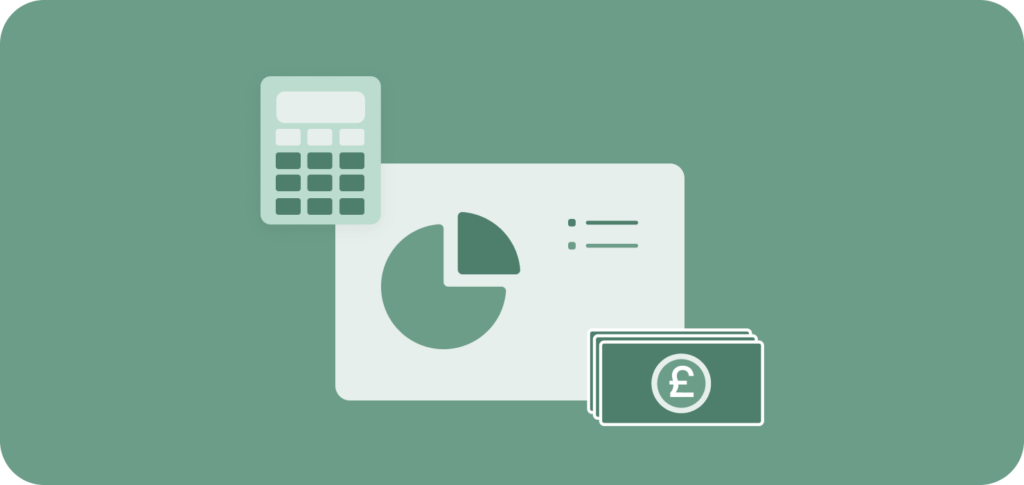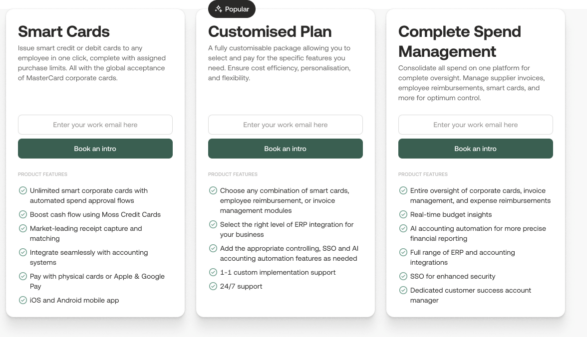To track and prove the financial performance of a business, KPIs are indispensable. There are many different metrics that can tell a company about its past, current and expected future financial status. If you’re wondering which performance indicators are most valuable, continue reading as we take a deep dive into this topic.
What are financial KPIs?

Financial KPIs (key performance indicators) are used to measure the financial performance of a business, whether for short-term insights or long-time evaluations of how well it is doing financially.
Based on the results, executives, managers, investors and banks can make more effective and informed business decisions. It is important to choose the right KPIs for your business, as they will help you track progress towards specific goals, and let you learn more about the health of your business.
Who works with financial KPIs?
Upper management, including the CEO, CFO, and other executives, rely heavily on financial KPIs to monitor the financial performance of the company and make informed decisions about financial strategy. On top of this, the board of directors, which is responsible for overseeing the management and direction of a company, uses financial KPIs to assess the strategic performance of the company and make recommendations for improvement. Employees may also be interested in financial KPIs, particularly if they have a stake in the company through stock options or other equity-based compensation.
But the financial performance and the overall health of a company is not only important for internal parties. There can also be a wide range of externals who may need to know more about financial success or certain challenges. Investors, including individuals, institutions, and analysts, use financial KPIs to assess the potential return on an investment and the risk associated with investing in a particular company. Moreover, government regulators, such as the Financial Conduct Authority (FCA) in the UK, use certain metrics to assess the financial health and stability of companies and ensure compliance with regulatory requirements.
Credit rating agencies like Moody’s and Standard & Poor’s, on the other hand, can check creditworthiness with specific KPIs to assign credit ratings. External auditors, like accounting firms, are employed specifically to assure the accuracy and reliability of a company’s financial statements and provide this information to stakeholders and other external organisations.
Financial KPIs: The most important categories
Financial KPIs can be grouped into several categories, depending on the focus of the metrics and the stakeholders who use them:
- Profitability KPIs measure a company’s ability to generate profit. Examples include net income and net profit margin.
- Liquidity KPIs reflect an organisation’s ability to meet its short-term financial obligations. Examples include current ratio and operating cash flow ratio (OCF).
- Solvency KPIs cover long-term financial stability and the ability to pay debts. Examples include debt to assets ratio and debt to equity ratio.
- Efficiency KPIs reveal if a company uses its resources effectively. Examples include average invoice processing cost and inventory turnover.
- Valuation KPIs allow stakeholders and investors to estimate a company’s value and the market’s expectations for its future performance. Examples include earnings per share and share price to earnings ratio.
By grouping financial KPIs into these categories, a company can simplify their analysis processes and also delegate responsibility accordingly. After all, knowing what to check and when to flag issues to senior management or C-level is essential for the finance department.
Essential financial KPIs for start-ups

Start-ups face unique challenges and opportunities, and financial KPIs can be an important tool for measuring and managing the financial performance and health of an up-and-coming business. Revenue growth might be one of the most crucial KPIs here, as percentage changes in a company’s revenue over a specific period of time can be a great key indicator of a start-up’s growth and success.
What’s more, gross margin reflects an organisation’s revenue after deducting the cost of goods sold. A high gross margin can indicate that a start-up is offering products or services in demand and generating solid profits. The percentage of a company’s revenue after deducting all expenses, including taxes and interest, is called net margin. A high net margin indicates that a start-up is efficiently managing its costs and working profitably.
Watch out for a high burn rate
Burn rate is a financial metric measuring the rate at which a company uses up its available capital, which can consist of loans or investments. Start-ups in particular need to keep an eye on this as their operating history is limited.
Burn rate is calculated by dividing a company’s monthly or annual operating expenses by the amount of available capital. Here is a simple example: If a start-up has £100,000 and spends £50,000 per month on operating expenses, its burn rate would be £50,000 per month or £600,000 per year. A company with a high burn rate may be at risk of running out of funds sooner than expected.
What are crucial revenue KPIs?

As we learned earlier, revenue is a key performance indicator that measures the amount of money a company generates from its business activities. There are certain specific revenue KPIs in that category that are especially interesting. Let’s start with gross revenue, for example. It refers to the total amount of money a company generates from its products or services before deducting any expenses. Net revenue, on the other hand, is the total amount after deducting costs.
Another useful KPI for certain businesses can be revenue per employee, which reflects the efficiency and productivity of the company’s workforce. The same goes for revenue by product or service, average revenue per customer, or revenue by distribution channel. Revenue growth gives you the percentage change in a company’s revenue within a specific time.
What are crucial liquidity KPIs?

Liquidity KPIs will inform you about a company’s ability to pay short-term debts and cover financial obligations. These indicators help ensure that a company has enough cash or assets, which is vital information for investors, partners, or banks.
A common liquidity KPI is the current ratio: It is calculated by dividing a company’s current assets by its current liabilities. A current ratio of 1 or higher indicates that a company has enough current assets to cover its liabilities. The quick ratio is similar but excludes inventory from the calculation of current assets. Why is this interesting? Because it may not be easy to convert inventory into cash to cover short-term debts. The cash ratio provides insights into an organisation’s ability to pay with its most liquid assets only. That can be available cash or short-term investments.
The point of working with investment KPIs

Investment KPIs significantly help measure the performance and effectiveness of a company’s investments. Evaluating and comparing is the key to success because all allocated resources should ideally support growth or raise profit.
There are several investment KPIs to consider. Their use depends on what the company intends to achieve:
- Return on investment (ROI): The profitability of an investment, calculated as the ratio of the gain or loss from an investment in relation to investment cost
- Internal rate of return (IRR): The expected return on investment with regard to the time value of money and the cash flows generated by the investment
- Net present value (NPV): The difference between the current value of the expected cash flows from the investment and the initial cost of the investment
- Capital expenditure (CapEx): The amount of money a company invests in assets, such as buildings, equipment, or technology, that are expected to generate long-term value
- Earnings per share (EPS): A company’s profitability on a per-share basis, calculated as net income divided by the number of outstanding shares
- Price-to-earnings ratio (P/E ratio): The relationship between a company’s stock price and its earnings per share which indicates the market’s expectations for future profitability
Here is an example to show how investment KPIs are used: A company is considering investing in a new product line and needs to determine if the investment is likely to be profitable. To do so, it calculates the NPV of the investment using a discount rate and the expected cash flows from the product line. If the NPV is positive, the company may decide to proceed with the investment. If the company has already invested in the new product line, it will want to track its performance over time. It sets several investment KPIs, such as the ROI, IRR and the payback period, and follows these metrics regularly.
How Moss helps you analyse KPIs

Automated data collection and analysis is the key to a successful business. Why? Because it’s not always possible to handle the sheer amount of data that a modern business generates manually, and present the financial KPIs so that they reflect all details correctly. The good news is you can save time and resources with Moss. Our tools allow you to collect financial data in real-time from your connected accounts. You can reduce the risk of errors from manual data entry and analysis.
Based on insights provided by Moss, you can make accurate, data-driven predictions for the future, allowing for smart financial planning, investing, and KPI adaptation.
But that is not all: Moss helps you keep track of your expenses in real-time, alerting managers and other stakeholders to potential issues or opportunities as they arise. All data can be exported to Xero to make accounting more effortless than ever. Combined with our safe virtual and physical cards that can be handed out to all employees, and even freelancers or subcontractors if needed, small and medium-sized organisations can prepare themselves for any situation daily business life throws at them.
FAQs
Financial KPIs, or key performance indicators, are crucial tools for businesses to measure and track their financial performance. These metrics allow organisations to assess their current financial status, set goals, and make good decisions for their economic well-being.
By regularly monitoring and analysing financial KPIs, businesses can gain valuable insights into their financial performance and take the necessary steps to improve it. Financial KPIs can be used in a variety of ways, including tracking progress towards financial goals, and communicating financial performance to investors, shareholders, and lenders.
Some financial KPIs that may be particularly significant for start-ups include revenue growth, gross margin, net margin, burn rate, customer acquisition cost (CAC), lifetime value (LTV), and cash flow. These KPIs can help start-ups track their progress, identify areas for improvement, and make informed decisions about their financial strategy.
To calculate financial KPIs, you will need to gather financial data such as revenue, expenses, or investments, and then use this data to perform calculations using formulas specific to each KPI. For return on investment, for example, you will need to divide the profit generated by an investment by the initial cost of the investment.
Liquidity refers to how easily an asset can be converted into cash. Investing is about financing something with the expectation of earning a return. A company’s liquidity and investment KPIs, therefore, measure very different aspects of business, either based on the availability of cash or the company’s profitability.
Burn rate measures how a company spends its cash over a certain period of time. This KPI can reflect a company’s financial health, providing insight into whether the company is generating enough cash to sustain its operations and meet its financial obligations.








